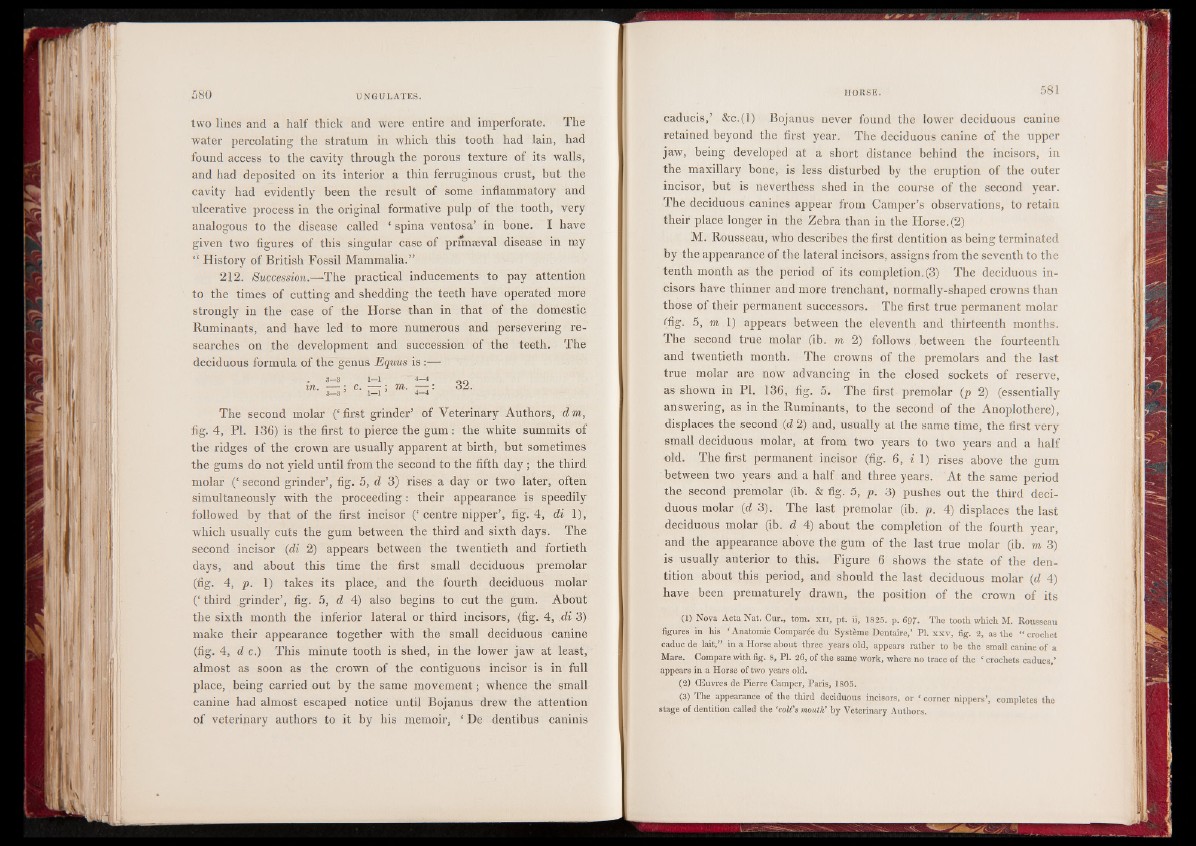
two lines and a half thick and were entire and imperforate. The
water percolating the stratum in which this tooth had lain, had
found access to the cavity through the porous texture of its walls,
and had deposited on its interior a thin ferruginous crust, but the
cavity had evidently been the result of some inflammatory and
ulcerative process in the original formative pulp of the tooth, very
analogous to the disease called ‘ spina ventosa’ in bone. I have
given two figures of this singular case of primaeval disease in my
“ History of British Fossil Mammalia.”
212. Succession.—The practical inducements to pay attention
to the times of cutting and shedding the teeth have operated more
strongly in the case of the Horse than in that of the domestic
Ruminants, and have led to more numerous and persevering researches
on the development and succession of the teeth. The
deciduous formula of the genus Eqms is :—
m1 . 3—-3 : c. —1-1 : to." *—-4 6QO1. 3—3 1—1 ’ 4—4
The second molar (‘ first grinder’ of Veterinary Authors, d to,
fig. 4, PI. 136) is the first to pierce the gum: the white summits of
the ridges of the crown are usually apparent at birth, but sometimes
the gums do not yield until from the second to the fifth day; the third
molar (‘ second grinder’, fig. 5, d 3) rises a day or two later, often
simultaneously with the proceeding: their appearance is speedily
followed by that of the first incisor (‘ centre nipper’, fig. 4, di 1),
which usually cuts the gum between the third and sixth days. The
second incisor (di 2) appears between the twentieth and fortieth
days, and about this time the first small deciduous premolar
(fig. 4, p. 1) takes its place, and the fourth deciduous molar
(‘ third grinder’, fig. 5, d 4) also begins to cut the gum. About
the sixth month the inferior lateral or third incisors, (fig. 4, di 3)
make their appearance together with the small deciduous canine
(fig. 4, d c.) This minute tooth is shed, in the lower jaw at least,
almost as soon as the crown of the contiguous incisor is in full
place, being carried out by the same movement; whence the small
canine had almost escaped notice until Bojanus drew the attention
of veterinary authors to it by his memoir, f De dentibus caninis
caducis,’ &c.(l) Bojanus never found the lower deciduous canine
retained beyond the first year. The deciduous canine of the upper
jaw, being developed at a short distance behind the incisors, in
the maxillary bone, is less disturbed by the eruption of the outer
incisor, but is neverthess shed in the course of the second year.
The deciduous canines appear from Camper’s observations, to retain
their place longer in the Zebra than in the Horse. (2)
M. Rousseau, who describes the first dentition as being terminated
by the appearance of the lateral incisors, assigns from the seventh to the
tenth month as the period of its completion. (3) The deciduous incisors
have thinner and more trenchant, normally-shaped crowns than
those of their permanent successors. The first true permanent molar
(fig. 5, to 1) appears between the eleventh and thirteenth months.
The second true molar (ib. to 2) follows, between the fourteenth
and twentieth month. The crowns of the premolars and the last
true molar are now advancing in the closed sockets of reserve,
as shown in PI. 136, fig. 5. The first premolar (p 2) (essentially
answering, as in the Ruminants, to the second of the Anoplothere),
displaces the second (d 2) and, usually at the same time, the first very
small deciduous molar, at from two years to two years and a half
old. The first permanent incisor (fig. 6, i l ) rises above the gum
between two years and a half and three years. At the same period
the second premolar (ib. & fig. 5, p. 3) pushes out the third deciduous
molar (d 3). The last premolar (ib. p. 4) displaces the last
deciduous molar (ib. d 4) about the completion of the fourth year,
and the appearance above the gum of the last true molar (ib. to 3)
is usually anterior to this. Figure 6 shows the state of the dentition
about this period, and should the last deciduous molar (d 4)
havé been prematurely drawn, the position of the crown of its
(X) Nova Acta Nat. Cur., tom. x i i , pt. ii, 1825. p. 697. The tooth which M. Rousseau
figures in his ‘Anatomie Comparée du Système Dentaire,’ PL xxv, fig. 2, as the “ crochet
caduc de lait;” in a Horse about three years old, appears rather to be the small canine of a
Mare. Compare with fig. 8, PI. 26, of the same work, where no trace of the ‘ crochets caducs,’
appears in a Horse of two years old.
(2) OEuvres de Pierre Camper, Paris, 1805.
(3) The appearance of the third deciduous incisors, or ‘ corner nippers’, completes the
stage of dentition called the ‘colt’s mouth’ by Veterinary Authors.